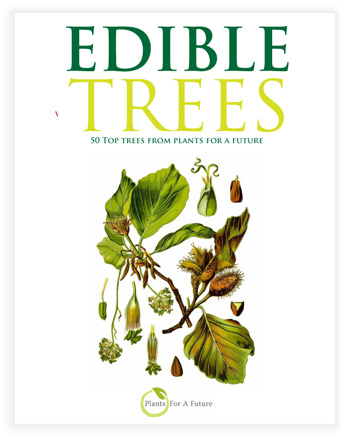50 Top Trees From Plants For A Future
A practical and inspirational guide from Plants For A Future on how to grow and harvest trees with edible and other useful produce.
 Authored by Plants For A Future
Authored by Plants For A Future
Edible Trees Book
Order from the following Amazon websites:
8.5" x 11" (21.59 x 27.94 cm)
Full Color on White paper
82 pages
When we think of edible trees we tend to focus on a few common varieties that give us fruit. However, many excellent less well-known trees can produce edible flowers, oil, seed, nuts, leaves, sap and bark as well as fruit. Many also have important medicinal applications. We also identify other uses of products derived from these trees, including fibres for clothes, rope and paper, oils for lubricants, fuels, water proofing and wood preservatives, dyes, construction materials, and more. In this book we describe 50 of our favourite edible trees, each one illustrated and arranged alphabetically by common name. Complementing the images is a physical description of each species, and information on their origin, growth-habit, preferred hardiness zone, edible and medicinal ratings, known hazards, weed potential, propagation, care and cultivation.
This book describes and provides advice on growing Plants For A Future’s favourite edible trees.
Edible Trees Book
Order from the following Amazon websites:

The digital book is $12 USD (approximately £7.65 GBP and €9.60 Euros)
Includes:
1. Almond, Sweet Prunus dulcis,
2. Apple Malus domestica ,
3. Beech Fagus sylvatica,
4. Buckthorn species,
5. Buckthorn, Sea Hippophae rhamnoides,
6. Buckthorn, Willow-Leaved Sea Hippophae salicifoliac,
7. Chestnut, Sweet or Spanish Castanea sativa,
8. Citrus, Lemon Citrus limon,
9. Citrus, Sweet Orange Citrus sinensis,
10. Damson Prunus insititia,
11. Dogwood species,
12. Dogwood, Japanese Cornus kousa,
13. Dogwood, Chinese Cornus kousa chinensis,
14. Fig Ficus carica,
15. Ginkgo biloba. Maidenhair Tree,
16. The Hawthorns,
17. Hawthorn, Arnold Crataegus arnoldiana,
18. Hawthorn, Blue Crataegus tournefortii,
19. Hawthorn, Pennsylvanian Crataegus pennsylvanica,
20. Hawthorn, Scarlet Crataegus pedicellata ellwangeriana,
21. Hawthorn, Tansy-Leaved Thorn Crataegus tanacetifolia,
22. Hazel, Cobnuts Corylus avellana,
23. Hazel, Filbert Corylus maxima,
24. Redbud Cercis Canadensis,
25. Judas Tree Cercis siliquastrum,
26. Jujube, Red date, Chinese date, Korean date, or Indian date Ziziphus jujuba,
27. Kaya Torreya nucifera,
28. Laurel, California. Oregon Myrtle Umbellularia californica,
29. Lime species,
30. Lime, Small Leaved, Small-leaved Linden Tilia cordata,
31. Lime, Large Leaved, Bigleaf Linden Tilia platyphyllos,
32. Lime, Common (UK) or Common Linden (USA) Tilia x europaea,
33. Loquat Eriobotrya japonica,
34. Medlar Mespilus germanica,
35. Monkey Puzzle Tree Araucaria araucana,
36. Mulberry, Black Morus nigra,
37. Oak, Holly Quercus ilex,
38. Oak, Holm Quercus ilex ballota,
39. Olive Olea europaea,
40. Peach Prunus persica,
41. Pear Pyrus communis,
42. Persimmons,
43. Persimmon, Caucasian, Lilac or Date Plum Diospyros lotus,
44. Persimmon, American. Common, "Sugar-plum" Diospyros virginiana,
45. Pine, Rocky Mountain Piñon Pinus edulis,
46. Pine, Korean Nut Pinus koraiensis,
47. Plum, European Prunus domestica,
48. Quince Cydonia oblonga,
49. Sassafras Sassafras albidum,
50. Sorbus species,
51. Service Tree, Sorb Apple Sorbus domestica,
52. Serviceberry, Juneberry or Snowy mespilus Amelanchier lamarckii,
53. Sheepberry Viburnum lentago,
54. Caragana species,
55. Siberian Pea Tree Caragana arborescens,
56. Strawberry Tree Arbutus unedo,
57. Walnut, English Juglans regia,